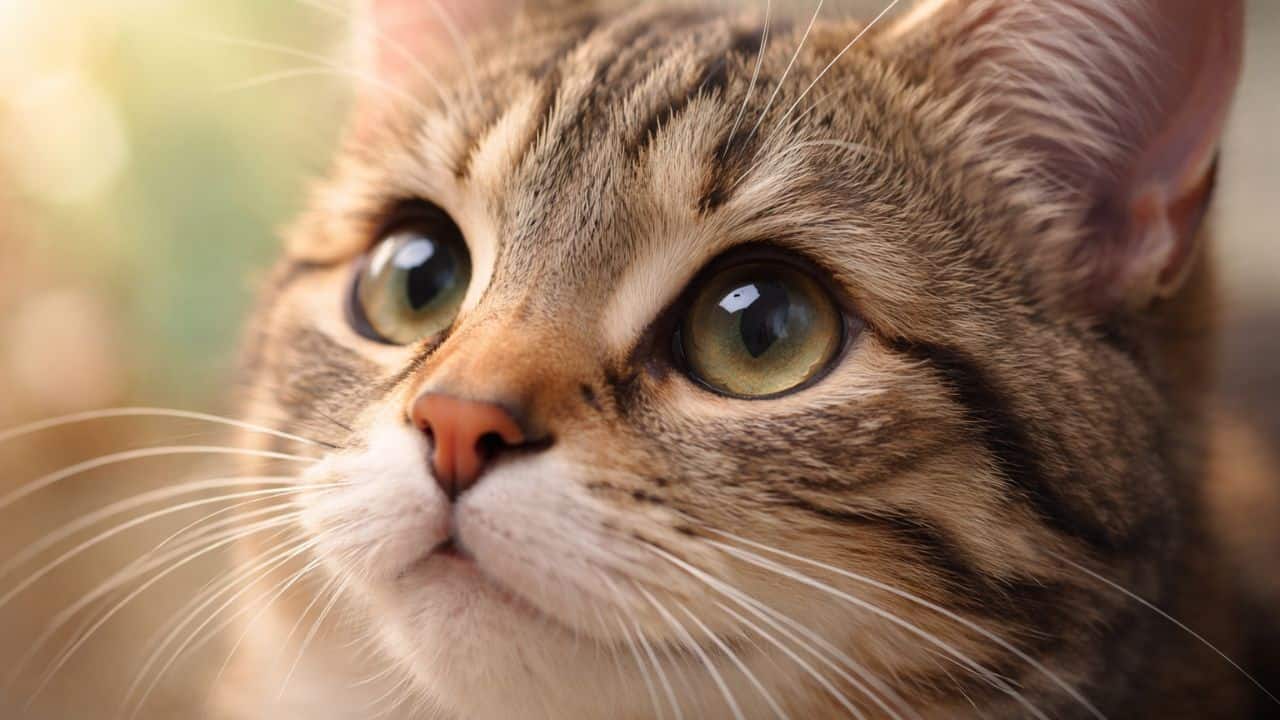Yes — cats do have eyelashes, but they’re shorter and stiffer than human lashes and mainly act as tiny sensors and shields.
They sit along the eyelid margin, trigger a blink if something touches them, and help divert dust and moisture away from the eye.
Unlike human lashes, cat lashes are less about appearance and more about protecting delicate vision in close-range situations.
Anatomy of a Cat’s Eye
A cat’s eye has several important structures that work together to allow cats to see well. The main external parts include the eyelids, eyelashes, and tear ducts.
The eyelids protect the eye from dirt and debris. Cats have an upper and lower eyelid on each eye that blink regularly to lubricate the surface of the eye.
Eyelashes extend from the edge of the eyelid and also help prevent dirt from getting into the eye. Cats have rows of very fine, short hairs along the upper and lower eyelids. The hairs act like a net to filter particulates from getting in the eye.
Tear ducts produce tears that clean and moisturize the surface of the eye. Cats have an extra tear duct called the third eyelid located in the inner corner of the eye. The third eyelid distributes tears across the eye when cats blink.
Inside the eye, cats have a pupil, iris, lens, cornea, retina, and other parts similar to humans. But the external anatomy around a cat’s eye, including eyelids, eyelashes, and tear ducts, has adapted to their needs as cats.
Comparing Cat and Human Eyelashes
Cats and humans both have eyelashes, but there are some key differences between them.
Cats have whiskers, while humans have hairs. A cat’s whiskers are thicker, stiffer, and spaced further apart than human eyelashes. Whiskers tend to protrude outwards from the face more than eyelashes.
The eyelashes of cats are also generally shorter than human lashes. The average human eyelash is 10-15mm long, while a cat’s whiskers are around 6-8mm in length.
In addition, cats have whiskers on the upper and lower eyelids, whereas humans only have upper eyelashes. So cats have more eyelashes overall surrounding the eye.
The distribution of eyelashes is also different. Humans tend to have lashes evenly spaced along the eyelids. But cats often have groups or tufts of whiskers in certain spots, like the outer corners of the eyes.
So, while both species have eyelashes, cats have thicker, shorter, and more spread-out whiskers than human eyelashes. The differing anatomy serves various purposes related to the abilities and environment of felines.
Functions of Eyelashes
A cat’s eyelashes serve several important functions related to protecting the eyes and aiding vision.
The primary role of eyelashes is to protect the eye from dust, debris, and other foreign objects that may irritate the eye or cause injury.
Eyelashes help keep harmful particles from getting into the eye by trapping debris and restricting airflow around the eye.
Their downward-angled position causes particles to bounce off the lashes rather than directly hitting the eyeball.
Eyelashes also aid vision by restricting light entering the eye. Just like the eyelids, lashes help moderate light levels coming into the eye to prevent glare and overexposure.
The lashes create a barrier and force light to enter at an angle, providing a soft-focus effect. This diffuses harsh light and creates better conditions for the pupil to contract and dilate.
By protecting the eyes and optimizing light intake, a cat’s eyelashes play an integral part in maintaining healthy eyes and sharp vision.
Their specialized structure and strategic positioning around the eye have evolved to serve these important ocular functions.
Proper eyelash health contributes significantly to a cat’s ability to see and navigate its environment clearly and safely.
Problems With Eyelashes
If lashes thin or fall out, see a vet — it can signal allergies, infection, trauma, or a skin condition, and treatment depends on the cause.
For example, the two of the most common problems with cat eyelashes are trichiasis and ingrown eyelashes.
Trichiasis
Trichiasis is a condition where the eyelashes grow inward toward the eye rather than outward. This can be an irritating and potentially painful problem for cats.
The misdirected eyelashes may scratch the surface of the eye, leading to corneal ulcers or other damage.
Trichiasis is often caused by abnormalities in the eyelids themselves. Weakness or scarring of the eyelid can allow the lashes to bend inward.
Eye infections or injuries can also distort the lid and follicles. In some cats, trichiasis may be present from birth as a congenital defect.
Treatment options for trichiasis include removing the abnormal eyelashes, electrolysis to prevent regrowth, or surgery on the eyelid to correct its shape and position.
It’s important to have veterinary care for this issue to prevent lasting damage to the eyes.
Ingrown Eyelashes
Ingrown eyelashes occur when an eyelash grows in a curled shape and punctures back into the eyelid. This can cause irritation, swelling, infection, and discomfort around the eye. The problem may affect one or multiple eyelashes.
Ingrown lashes are primarily caused by follicular disorders. The hair shaft emerges from the follicle in the wrong direction. Trauma, scarring, or congenital defects can also lead to ingrown hairs.
To treat ingrown eyelashes in cats, the affected hair is removed using sterile forceps. Usually, no anesthesia is required for this quick procedure.
The area may be treated with antibiotic ointment to prevent infection as the hair regrows properly. In some recurring or severe cases, the eyelash follicles themselves may need to be surgically removed.
Grooming Cat Eyelashes
Cats rely on their caretakers to help groom their eyelashes. Here are some tips for keeping your cat’s eyelashes healthy and clean:
Gentle Cleaning with a Damp Cloth
Use a soft, damp cloth or cotton pad to gently wipe away any debris or discharge from your cat’s eyelashes and the area around the eyes. Avoid using soap or cleaners, as this can irritate their eyes. Be very gentle, and never scrub.
Trimming Overgrown Hairs
If hairs around the eyes grow too long, they can irritate the eyes. Use small, blunt scissors to carefully trim overgrown hairs. Just snip off the ends; don’t cut too close to the skin. Ask your vet to demonstrate proper technique if you’re unsure.
Applying Medication
If your cat has an eye infection or condition causing discharge, your vet may prescribe medicated eye drops or ointments.
Follow instructions carefully when applying medications to the eye area and eyelashes. Ensuring medication fully reaches the eye may require trimming overgrown hairs around the eyes first.
With a little care and grooming, your cat’s eyelashes can stay healthy, clean, and comfortable. Check with your veterinarian if you ever notice signs of irritation, infection, or discomfort around your cat’s eyes.
Proper eyelash hygiene is an important part of caring for your feline friend.
Myths About Cat Eyelashes
Cats are surrounded by an air of mystery, which leads to many myths and misconceptions about their anatomy and behavior.
One common myth is that cats don’t blink. While it’s true that cats don’t blink as frequently as humans, they do blink.
Cats typically blink about six to eight times per minute, whereas humans blink around 10 to 20 times per minute.
Cats also have a third eyelid called a nictitating membrane that can move horizontally across the eye to moisten and protect it. When resting, cats may close this third eyelid to block out light while remaining alert.
The myth that cats don’t blink likely stems from the fact that their eyes remain open wider than humans when blinking.
But just because their eyes remain partially open doesn’t mean they don’t blink. Blinking is vital for cats to keep their eyes lubricated and healthy.
So while a cat’s stare may seem unblinking and intense, rest assured that felines do blink. Their lower blink rate compared to humans simply means you have to observe them patiently to catch those brief but important eye closures.
Interesting Facts About Cat Eyelashes
Cats are known for being mysterious creatures, but their eyelashes hold some fascinating secrets! Here are some interesting facts about cat eyelashes:
- Cats can’t cry emotional tears like humans can. Their tear ducts work to lubricate their eyes and remove dust and debris. So even if your cat looks like it’s crying, it’s likely just an eye irritation or infection.
- Cats have a third eyelid called the nictitating membrane. It sweeps horizontally across the eye to clean and protect it. You may see this membrane briefly cover your cat’s eye when it blinks.
- A cat’s upper eyelid has approximately 12 to 16 lashes per lid. The lower lid only has around 6 to 8 eyelashes. Compared to the average person’s 90-160 upper and 75-130 lower eyelashes, cats have far fewer.
- Eyelashes enter the growth phase for about 5-6 weeks in cats. They then enter a rest phase for around 2-3 weeks before shedding. So cat eyelashes are continuously replaced over time.
- Kittens are born without eyelashes. They begin to develop them at around 2 weeks old. Kittens open their eyes for the first time once the eyelashes grow in at 1-2 weeks of age.
- Cats don’t need mascara! Their eyelashes are already naturally curved and long.
So a cat’s eyelashes serve many important functions for their vision and eye health. Those lovely lashes do way more than just look pretty!
Frequently Asked Questions
Do kittens have eyelashes at birth? Yes, kittens are born with eyelashes just like human babies. Their eyelashes at birth are very short and thin.
Over the first few weeks of a kitten’s life, their eyelashes will grow longer and thicker as they develop.
Do white cats have eyelashes? Yes, white cats do have eyelashes. Their eyelashes may be harder to see since they blend in with the white fur.
But all cats, regardless of their fur color, have eyelashes. White cats’ eyelashes serve the same function as eyelashes on cats with other coat colors. They help keep debris out of the eyes and also aid in communication.
The Importance of Healthy Eyelashes
Healthy eyelashes play an important role in your cat’s eye health and comfort. As a cat owner, it’s essential to regularly monitor your cat’s eyes for any potential problems with their eyelashes or eyes in general. Some signs to watch out for include:
– Excessive blinking or squinting
– Redness, swelling, or discharge in/around the eyes
– Loss of eyelashes
– Irritation, itchiness, or pawing at the eyes
– Sensitivity to light
If you notice any of these symptoms, schedule an appointment with your veterinarian right away.
They can examine your cat’s eyes closely and determine if there are any underlying issues. Left untreated, problems with eyelashes and eyes can lead to pain, vision issues, infections, and other complications.
Some common eye conditions associated with eyelash problems in cats include:
- Conjunctivitis – infection/inflammation of the conjunctiva
- Entropion – inward rolling of the eyelids
- Ectropion – outward sagging of the eyelids
- Trichiasis – ingrown eyelashes rubbing on the eye
- Distichiasis – the abnormal extra row of eyelashes
Your vet has various treatment options depending on the specific condition. This may include eye drops, ointments, antibiotics, surgery for ingrown eyelashes, etc.
With prompt treatment, most eye issues can be resolved or well-managed.
Going forward, be diligent about checking your cat’s eyes every day. Alert your vet if you see any recurrence of symptoms.
Keeping your cat’s eyelashes and eyes healthy will help avoid discomfort, maintain good vision, and support their overall well-being.

